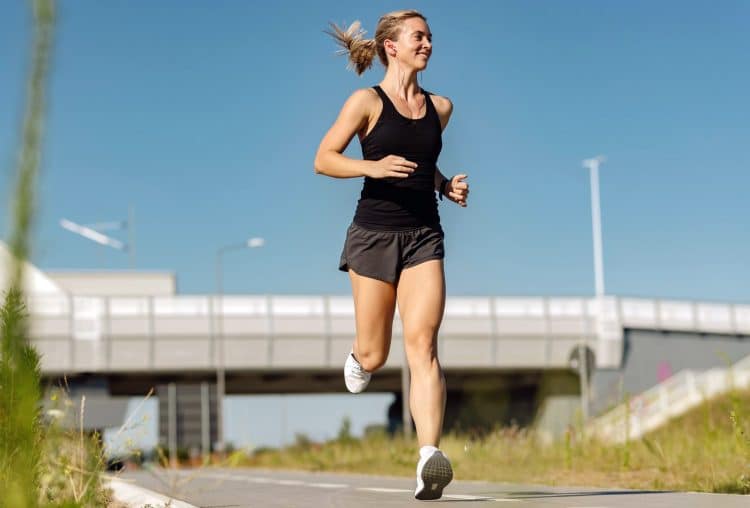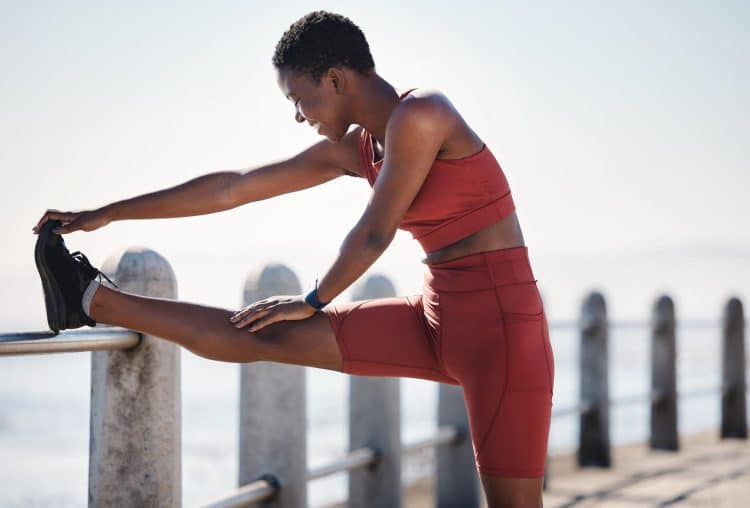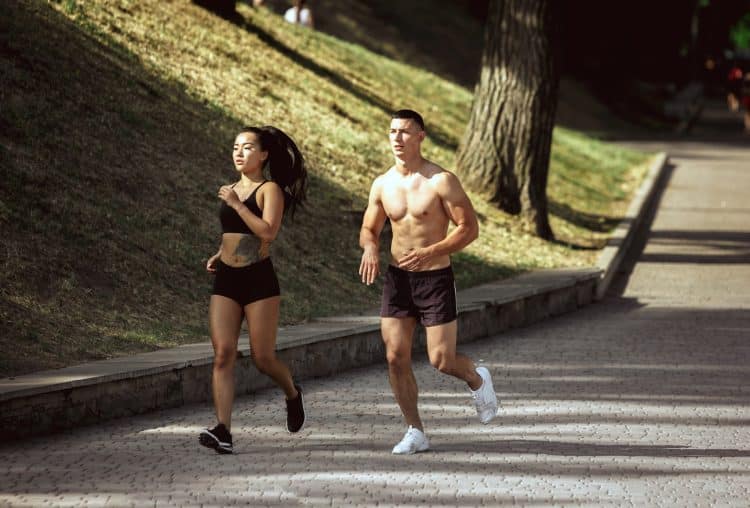The average speed for jogging falls between 4-6 mph (6.4-9.7 km/h), offering a comfortable pace faster than walking yet easier than running. This range accommodates various fitness levels, letting you find your sweet spot for enjoyable exercise.
Introduction
Remember that first jog? Heart pounding a samba against your ribs, legs pumping like pistons trapped in molasses. You glanced at your phone, seeking validation for your valiant effort.
“Pace: 8:23 min/mile,” it mocked. Was that good? Bad? Average?
That’s the rub with “average speed” in jogging — it’s a cruel mirage shimmering in the fitness desert.
It whispers promises of benchmarks and progress, only to leave you parched and confused.
For beginners, it’s a daunting yardstick, casting a shadow of inadequacy with every lumbering footfall. For seasoned joggers, it’s a bland buffet, offering a one-size-fits-all meal when their palates crave personalized spice.
Level Up Your Fitness: Join our 💪 strong community in Fitness Volt Newsletter. Get daily inspiration, expert-backed workouts, nutrition tips, the latest in strength sports, and the support you need to reach your goals. Subscribe for free!
This article isn’t about chasing that elusive mirage. Forget “average.” We’re here to help you discover your optimal jogging pace, the sweet spot where your body sings and your spirit soars.
This isn’t a race against the clock or your neighbor’s Strava feed; it’s a dance with your own rhythm, a symphony of comfort and progress.
So, lace up your shoes, grab your curiosity, and let’s dive in. We’ll break down the myth of “average,” explore the factors that shape your unique pace, and equip you with tools to find your personal groove.
Average Speed for Jogging: Unveiling the Numbers
The average jogging speed is a question that plagues beginners and seasoned runners alike, a benchmark we chase and a metric we measure ourselves against.
But before we get tangled in a web of competitive mile splits, let’s unveil the truth: there’s no one-size-fits-all answer.
Your personal average is a beautiful tapestry woven from threads of gender, age, and experience, each strand influencing the rhythm of your stride.
Here’s a peek into the diverse landscape of average jogging speeds:
Gender:
- Men: Generally speaking, men tend to clock in a tad faster, with an average jogging speed between 5.5 and 7 mph (8.9 and 11.3 kph). Think comfortable conversations at a brisk clip.
- Women: Women, on the other hand, typically average between 4.5 and 6 mph (7.2 and 9.7 kph). Imagine a lively podcast keeping you company as you glide along.
Age:
- 20-30s: This age group often boasts the swiftest averages, hitting 6-7.5 mph (9.7-12.1 kph) with ease. Picture effortlessly leaving dust trails in your wake.
- 40-50s: Experience and wisdom reign supreme here, with averages settling comfortably between 5-6.5 mph (8.1-10.5 kph). Think steady, controlled paces fueled by years of dedication.
- 60+: Don’t underestimate the power of seasoned grace. This age group inspires awe, with averages often hovering around 4-5.5 mph (6.4-8.9 kph). Imagine purposeful strides fueled by an unyielding spirit.
Experience Level:
- Newbies: For those just starting out, a comfortable conversational pace of 4-5 mph (6.4-8.1 kph) is ideal. Listen to your body, embrace the walk-run intervals, and let your fitness blossom gradually.
- Intermediate: With consistent training, your average can climb to 5-6 mph (8.1-9.7 kph). You’ll find yourself cruising past scenic vistas, lost in the rhythm of your run.
- Advanced: Averages for seasoned runners often soar to 6-7 mph (9.7-11.3 kph) and beyond. Hills become mere bumps, and distances dissolve into exhilarating challenges.
Remember, these are just averages, not absolutes. Your unique physiology, fitness level, and terrain all play a role in sculpting your personal pace.
The key is to find a speed that feels comfortable, sustainable, and enjoyable. Listen to your body, respect its rhythms, and celebrate every stride.
Factors Affecting Average Jogging Speed
Given below are the factors that affect your average speed for jogging:
Physiological Factors: The Engine Room
Imagine your jog as a finely tuned machine. Your body is the engine, powered by a complex interplay of physiological factors. Here’s a peek under the hood:
- Age: Like a well-worn engine, your body loses some efficiency with time. Muscle mass diminishes, lung capacity dips and metabolism slows, leading to a gradual decrease in average jogging speed. But don’t despair. Regular running can actually mitigate these effects, keeping you sprightly well into your golden years.
- Gender: Men, with their larger muscle mass, tend to jog slightly faster than women. However, women boast superior fat-burning capabilities, often excelling in longer distances. Ultimately, gender plays a smaller role than individual fitness levels.
- Fitness Level: The secret sauce to speed? A well-oiled engine. The fitter you are, the more efficiently your body utilizes oxygen, converts energy, and propels you forward. Regular running, interval training, and strength workouts are your fuel injectors, boosting your average jogging speed with each session.
- Body Composition: Carrying extra weight is like lugging a backpack uphill. A higher body fat percentage translates to more energy expended per stride, impacting your average speed. However, focusing on building muscle mass, not just reducing weight, can improve your overall running economy and power output.
- Heart Rate Zones: Think of your heart rate as a speedometer. Each zone dictates the intensity and efficiency of your run. Jogging in the lower zones, where conversation is easy, builds aerobic base and improves endurance, while in higher zones, where breathing quickens, builds speed and power. Finding the sweet spot for your average jogging pace is key.
Environmental Factors: The Playground of Pace
The world outside is your running canvas; its features can significantly influence your brushstrokes. Consider these terrain-based tweaks:
- Terrain: Flat, smooth paths are your allies, allowing for long, effortless strides. Hills, however, demand strength and power, slowing your average speed. Embrace them as strength-building intervals, and watch your pace climb with consistent training.
- Weather Conditions: A gentle breeze is a runner’s friend, but scorching sun, biting wind, or pouring rain can sap energy and impede your average jogging speed. Dress appropriately, adjust your pace, and seek shade or shelter when necessary.
- Elevation: Running at altitude is like training with thinner air. Oxygen becomes scarce, and your average speed dips. However, the reward? Stronger lungs and a newfound appreciation for flatland sprints.
- Time of Day: Are you a sunrise warrior or a sunset seeker? The time you choose to jog can subtly affect your pace. Morning runs offer cool temperatures, while evening jogs benefit from lower stress levels. Experiment and find your ideal running window for optimal average speed.
Training Factors: The Art of the Hustle
Your training program is the sculptor of your running form. Here’s how to chisel your average jogging speed into a masterpiece:
- Running Experience: The more miles you log, the more efficient and powerful your stride becomes. Seasoned runners boast higher average speeds than beginners, but remember, everyone starts somewhere. Be patient, celebrate progress, and enjoy the journey.
- Workout Routine: Variety is the spice of training! Mixing up your runs — intervals, tempo runs, long runs, recovery jogs — keeps your body challenged and prevents plateaus. This translates to a well-rounded skillset and improved average jogging speed across all distances.
- Recovery Periods: Rest is not idleness; it’s refueling. Adequate sleep, stretching, and active recovery activities like swimming or yoga are crucial for rebuilding muscle, preventing injuries, and ensuring you hit the pavement ready to crush your average jogging speed goals.
- Footwear: The right shoes are your trusty companions on the road. Investing in good-quality running shoes that match your foot type and running style can make a world of difference. Proper support and cushioning not only prevent injuries but also improve your stride efficiency, boosting your average jogging speed.
Psychological Factors: The Mind Matters
Your mental state is the invisible hand guiding your feet. Don’t underestimate its power:
- Motivation: What fuels your fire? Finding your “why” — be it weight loss, stress relief, or simply the joy of movement — keeps you motivated and pushing your boundaries, propelling your average jogging speed forward.
- Mindset: A positive attitude and unwavering self-belief can unlock hidden reserves of energy and determination, shattering mental barriers and propelling your average jogging speed to new heights. Remember, doubt is a whisper in the wind; let your stride shout your confidence for all to hear.
- Music: The right playlist can be a magical motivator. Upbeat music can elevate your mood and boost your pace while calming tunes can help you find your flow and maintain a steady average jogging speed. Experiment and discover the soundtrack that fuels your soul and your stride.
- Competition: A little friendly rivalry can go a long way. Joining a running group, participating in races, or simply setting personal goals can add a touch of healthy competition to your routine. The desire to improve, to outpace your yesterday, can propel you beyond your perceived limits and rewrite your average jogging speed record.
Pro Tip: Calories Burned Running Calculator
Level Up Your Fitness: Join our 💪 strong community in Fitness Volt Newsletter. Get daily inspiration, expert-backed workouts, nutrition tips, the latest in strength sports, and the support you need to reach your goals. Subscribe for free!
Busting the Myth of “Average”
Steer clear of the following average jogging speed myths:
1. Chasing Shadows
Average jogging pace? It’s as elusive as a unicorn on a treadmill. Charts plastered across the internet might tempt you with neat little boxes for “female, 30s,” but here’s the truth: those averages are about as valuable as a one-size-fits-all running shoe.
2. Age Ain’t a Number (for Your Pace, Anyway)
Imagine a 20-year-old Olympian and a 60-year-old marathoner sharing the same “average” pace. Absurd, right? Age is just one piece of the puzzle and a wobbly one at that. Genetics, fitness level, training history, even that pre-run bagel — they all play a symphony in determining your unique rhythm.
3. Gender? Just Another Piece of the Mosaic
Grouping all women or all men under one pace umbrella is like claiming every tree in the forest is the same shade of green. Sure, there might be trends, but individual branches tell a different story. My female clients range from 8-minute milers to power-walkers conquering hills with determination. It’s all about honoring your own biomechanics and goals.
4. Charts? More Like Cartoons
Don’t get me wrong, I love a good map. But those “average speed” charts? They’re more like caricatures than blueprints. They ignore factors like terrain, weather, course elevation, and the emotional rollercoaster of that last hill. Your body whispers its ideal pace, not some generic chart on a website.
5. The Peril of Pursuit
Chasing an average is like chasing smoke. It fuels frustration, invites injury, and can extinguish your love for the run. Imagine pushing yourself to a 9-minute mile to “meet the chart,” only to end up with shin splints and a deflated spirit. Remember, the only race you’re in is with yourself, and your finish line is joy, not a random number.
6. Embrace the “Me” in Pace
Your perfect pace is as unique as your fingerprint. It’s not about comparing; it’s about discovering. Listen to your breath, feel the rhythm of your feet, and let your body guide you. It’s a conversation, not a competition.
7. Average Speed for Jogging? Forget It. Focus on Joy
Ditch the charts, the comparisons, and the pressure. Find a pace that makes you want to lace up your shoes every day, that leaves you exhilarated, not exhausted. That, my friend, is the average speed for your perfect jog.
Finding Your Optimal Jogging Pace
The average speed for jogging is a mythical beast often chased by novice and veteran runners alike, but pinning it down is harder than catching a greased cheetah.
So, instead of chasing shadows, let’s focus on finding your own optimal pace, the sweet spot where you reap the benefits of a good sweat without getting trampled by the herd. Buckle up because we’re diving deep into the science and strategy of personalized jogging speed.
Step 1: Self-Assessment — Know Your Starting Line
Before you lace up and hit the pavement, take a moment for introspection. Here’s your pre-jog checklist:
- Fitness Level: Are you a seasoned runner with lungs of steel or a newbie navigating the uncharted territory of your neighborhood park? Honestly assess your current fitness. A brisk walk in the park and a 5K race require vastly different paces.
- Goals: What do you hope to achieve with your jog? Is it weight loss, cardiovascular health, or simply the joy of movement? Different goals demand different speeds. A leisurely jog for stress relief won’t be the same sprint you’d use for a timed race. (1)
- Terrain: Concrete jungle or leafy trail? Flat path or hilly rollercoaster? Consider the terrain’s impact on your pace. Hills will naturally slow you down, while a smooth track might tempt you to pick up the tempo.
Step 2: Pace Measurement Tools — Your Navigational Compass
Now that you know your starting point, it’s time to grab your map and compass. These tech-savvy tools will help you chart your course:
- GPS Watches: Your wrist-mounted guide, these handy gadgets track your distance, pace, and even heart rate. Perfect for data-driven runners who love crunching numbers (and admiring their sleek wrist real estate).
- Running Apps: Turn your phone into a pocket coach! Many apps offer pace tracking, interval timers, and even personalized training plans. Budget-friendly and feature-packed, they’re a great option for tech-savvy runners.
- Heart Rate Monitors: These trusty chest straps or wristbands monitor your ticker, giving you real-time feedback on your exertion level. Ideal for training in specific heart rate zones, they’re a favorite among serious runners.
- Lactate Threshold Testing: For ultimate precision, consider a lactate threshold test. This lab-based assessment measures your blood lactate levels, revealing the pace at which your body starts producing too much lactate, impacting performance. A bit pricier, but invaluable for maximizing your training.
Step 3: Training Techniques — Mastering the Art of Speed Play
Just like a sculptor chisels a masterpiece, you can shape your perfect pace through targeted training techniques:
- Interval Training: Alternate high-intensity bursts with recovery periods, pushing your limits and building endurance. Think sprinting lampposts during your jog, then coasting to catch your breath.
- Fartlek: Swedish for “speed play,” this freestyle method involves spontaneous changes in pace, mimicking the flow of nature. Imagine chasing butterflies during your jog, then strolling through a scenic meadow.
- Tempo Runs: Sustain a comfortably hard pace for a set distance, building your lactate threshold and mental toughness. Think of it as a controlled burn, pushing yourself without going overboard.
- Progressive Runs: Gradually increase your pace throughout your run, mimicking race-day conditions. Start easy, then dial it up like a musician crescendoing towards the finale.
Step 4: Listening to Your Body — The Wisdom of Your Inner Coach
No fancy gadget can replace the wisdom of your own body. Pay attention to these fatigue cues:
- Heavy Breathing: Struggling to hold a conversation? Slow down; your lungs are begging for mercy.
- Tight Muscles: Feeling like a walking pretzel? Ease off; your muscles need a break.
- Dizziness or Lightheadedness: Brain feeling foggy? Stop immediately; dehydration or overheating might be at play.
Remember, pushing through pain isn’t heroic; it’s foolhardy. Adjust your pace, take breaks, and respect your body’s signals.
Step 5: The “Talk Test” – Your Conversational Compass
Finally, there’s the good old-fashioned “talk test.” Can you hold a conversation while jogging? If yes, you’re probably in your “fat-burning zone,” a comfortable pace for sustained exercise.
Check Out: Running Pace Calculator
Conclusion
The average speed for jogging can be a misleading mirage.
Instead of chasing some arbitrary number, we’ve learned that finding your own sweet spot is the true treasure map to a sustainable and satisfying running journey.
Forget the finish line for a moment. The real prize is the freedom that unfolds with each stride. Freedom from stress, from routine, from the confines of your own mind.
Running is liberation, a gateway to a universe where endorphins paint the clouds, and fresh air fuels your soul.
If you have any questions about the average speed for jogging, drop them in the comments below, and I’ll be happy to help!
References
- Oswald, F., Campbell, J., Williamson, C., Richards, J., & Kelly, P. (2020). A Scoping Review of the Relationship between Running and Mental Health. International journal of environmental research and public health, 17(21), 8059. https://doi.org/10.3390/ijerph17218059












